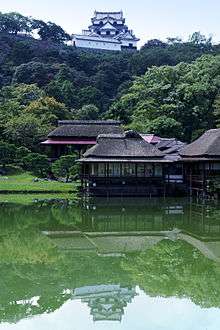Borrowed scenery
| Borrowed scenery | |||||||
|
Borrowed scenery in the style of Song and Ming Dynasty gardens located at the Zhishan Garden | |||||||
| Chinese name | |||||||
|---|---|---|---|---|---|---|---|
| Chinese | 借景 | ||||||
| |||||||
| Japanese name | |||||||
| Kanji | 借景 | ||||||
| |||||||
Borrowed scenery (借景; Japanese: shakkei; Chinese: jièjǐng[1]) is the principle of "incorporating background landscape into the composition of a garden" found in traditional East Asian garden design. The term borrowing of scenery ("shakkei") is Chinese in origin, and appears in the 17th century garden treatise Yuanye.[2]

Borrowed scenery in the Sakuteiki
The term borrowed scenery is not mentioned in the oldest extant Japanese garden manual, the Sakuteiki (作庭記, "Records of Garden Making"). However, this text, which is attributed to Tachibana Toshitsuna (橘俊綱, 1028-1094 CE), a son of the Byodoin's designer Fujiwara no Yorimichi (藤原頼通, 990-1074 CE), records as one of the first principles of garden making:
According to the lay of the land, and depending upon the aspect of the water landscape, you should design each part of the garden tastefully, recalling your memories of how nature presented itself for each feature. (tr. Inaji 1998:13)
Three principle tenets guiding Japanese garden organization are,
- shōtoku no sansui (生得の山水, "natural mountain river") intending to create in the likeness of nature
- kohan ni shitagau (湖畔に従う, "follow the lakeshore") planning in accordance with the site topography
- fuzei (風情, "appearance; air") capturing and presenting the ambiance
Shakkei, which attempts to capture nature alive rather than create a less spectacular version, can be taken as to allude to the first of these categories.
The origins of an interest in the landscape outside the Heian period gardens, Shinden-zukuri gardens, lie in the increased local travel of the Japanese elite, a layered endeavor involving the bolstering of a national identity separate from China and the display of personal wealth. When they returned from their travels they would want to physically manifest these travels at home in a more ostentatious way than could be accomplished solely with art, weapons, or ceramics. Thus, borrowed scenery was introduced to incorporate the foreign landscapes seen in northern Japan into the southern cities of Nara and Kyoto.
According to the 1635 CE Chinese garden manual Yuanye (園冶), there are four categories of borrowed scenery, namely: yuanjie (遠借 "distant borrowing", e.g., mountains, lakes), linjie (隣借 "adjacent borrowing", neighboring buildings and features), yangjie (仰借 "upward borrowing", clouds, stars), and fujie (俯借 "downward borrowing", rocks, ponds); respectively Japanese enshaku, rinshaku, gyōshaku, and fushaku.
References
- ↑ Stepanova, Jekaterina (2010). Kraushaar, Frank, ed. Eastwards: Western views on East Asian culture. Bern: Peter Lang. p. 162. ISBN 978-3-0343-0040-7.
- ↑ Kuitert, Wybe (2002). Themes in the history of Japanese garden art. Honolulu: University of Hawai'i Press. p. 177. ISBN 978-0-8248-2312-2.
Notes
- Slawson, David A. Secret Teachings in the Art of Japanese Gardens. New York: Kodansha International Ltd., 1987
- Takei, Jiro and Mark Peter Keane. The Sakuteiki: Visions of the Japanese Garden. North Clarendon, VT: Tuttle Publishing, 2001.
- Tsu, Frances Ya-sing. Landscape Design in Chinese Gardens. New York: McGraw-Hill Book Company, 1988.
External links
- shakkei 借景, Japanese Architecture and Art Net Users System
- SHARAWAGGI, Peter Laurence
- Natural and Built Environment Relationships in Asian Architecture, Jennifer M. Lo
- Examples of borrowed scenery in Tsubo-en and some other Japanese gardens.